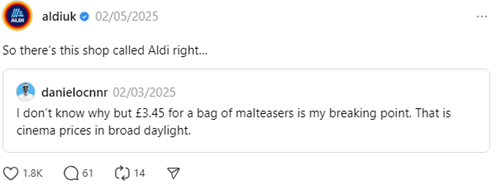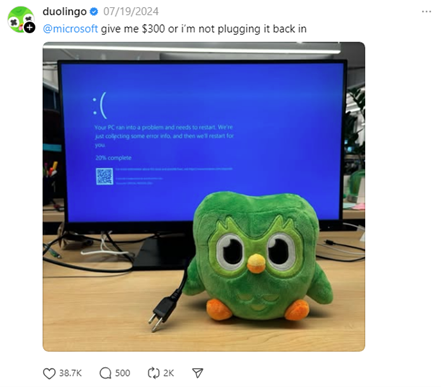Our Social Media Predictions for 2025
Social media has very quickly taken over the digital world. As of February 2025, there were 5.24 billion active social media users worldwide, which is 63.9% of the world's population. For many brands and businesses, it is now an essential marketing tool to raise brand awareness and engagement. Without it, you may find it harder to make your mark.
In the last few years, marketers have seen a lot of change in how users consume social media content both in business and as consumers. Platforms that once dominated are quickly being replaced with new channels, and the way people consume social media content is constantly adapting. For businesses, having a presence on social media is necessary to stay relevant and compete in the highly saturated market.
Our social media managers have explored what they think the biggest social media trends will be in 2025, and what they mean for brands looking to future-proof their marketing strategies.
The Decline of X and the Rise of Bluesky & Threads
At the time of writing this blog, X (formerly Twitter), has an estimated 611 million monthly active users, but user numbers have declined since Elon Musk took over in 2022. When Musk acquired X, users started to see a surge in misinformation, hate speech and toxic discourse. This led to many users becoming increasingly concerned about content moderation and policy changes, as there had been a sudden shift in the prioritisation of free speech. As a result, the number of users began to decline.
From our research, figures really vary when it comes to how many people have removed themselves from the social networking site. However, trends show that over a third of daily UK users have left, with many shifting to alternatives like Bluesky (30 million users) and Threads (130 million users), which have stricter policies and decentralised control. If users continue to seek alternatives, we could see platforms such as Bluesky and Threads surpass X, but there is still a long way to go.
This decline isn’t limited to individual users – brands are also reconsidering their presence on X. Since Musk’s takeover, major companies like IBM, Paramount, and The Walt Disney Company have distanced themselves from the platform. More recently, the charity Mind publicly announced its departure, stating, “We’ve decided that X is no longer the right place for us to reach the people we need to reach or achieve the things we need to achieve.”
For brands, this shift raises important questions. Does X still align with your marketing objectives and audience expectations? This year, it may be worth considering this for your own business and diversifying your existing social strategy with alternatives such as Bluesky or Threads.
Instagram’s Evolution
It is no secret that Instagram has very quickly become one of the most popular marketing tools for brands/businesses. Its popularity exceeds the likes of X, with over 2 billion monthly active users. For brands, Instagram (along with Tik Tok) remains the best way to reach a younger audience, as 91% of Generation Z social media users are on Instagram. It’s the most popular platform for ecommerce, organic engagement, and more recently influencer marketing.
The app is continually evolving, with recent updates designed to position it as the ultimate social platform. For example, Instagram recently adjusted its image post size to better integrate Reels, a move to compete more directly with TikTok. We expect Instagram will continue to change and evolve throughout 2025. If your brand isn't on Instagram yet, it may be time to re-think your strategy.
Personalised Content and Community Engagement
Generic content is a thing of the past, if you really want to stand out this year on social media, you need to create content that is more personable. Users want to see the humans behind a brand, and what makes the brand stand out from their competitors. This doesn’t mean that you need to steer away from professionalism and service-based posts, but integrating your feed with the people behind the brand will help you to stand out.
This year, you also need to consider how you build relationships with the people that view your content. Regularly replying to comments, providing interactive content and having direct engagement will set you apart from other brands. This doesn’t just stop at B2C, it also works for B2B.
Brands such as Aldi, Duolingo and Ryan Air are all great examples of this (see below). They have all mastered community engagement and personalised content on social media, using humour, brand personality and timely interactions to build customer loyalty. This year, ensure you use your brands unique voice to engage authentically with your audience, and create posts that will resonate with your users.



Continued Growth of Short-Form Video
With video content on the rise, Tik Tok, reels and shorts are becoming the most popular way of engaging with brand content. LinkedIn have even said they have seen a 36% increase in watch time and are constantly adapting their platform to incorporate videos into their main user feed. Short-form videos are a great way to maximise engagement and storytelling for your brand. We’ve seen first-hand the success of reels for our own Red Ant Solutions Instagram account, and it’s something we would encourage all brands to integrate through their content to show the ‘real’ behind the scenes, especially as it is becoming the norm for more and more platforms.
There is no stopping short-form video content with Tik Tok, Instagram, YouTube and LinkedIn providing users with this content. Who knows what the future has to hold for video content. We could see AI-enhanced editing, and more interactive videos. CapCut already produces videos for you based on an AI prompt, so this is something we can guarantee will step up in 2025.
Ethical & Authentic Content
Consumers have become even more sceptical of inauthentic influencer marketing. We are now seeing a rise in ‘de-influencing’, where audiences challenge the credibility of influencer endorsements, reflecting a growing demand for transparency and ethical storytelling.
As a brand, when you are marketing your products and services ensure you are balancing authenticity with strategic marketing. You need to show that what you are promoting truly works, and not just because a few influencers told everyone it does.
What does the future hold?
It is hard to predict what the future looks like for social media development, but these trends and predictions show some of the key shifts that could happen in 2025. Brands need to ensure they stay flexible and proactive to remain competitive on social media.
This year, as a business owner or part of a brand's marketing team, you should spend some time evaluating your use of social media. Assess whether platforms like X still align with your brand goals, and consider other options such as Bluesky or Threads. Make sure you are producing personalised content, short-form video content and really emphasise authenticity and transparency. More importantly, make sure you monitor your ongoing performance and stay reactive so you can adapt your strategy when needed.
If you’re looking for expert guidance on navigating these changes and optimising your social media strategy, get in touch with a member of our social media team today.
17 February 2025